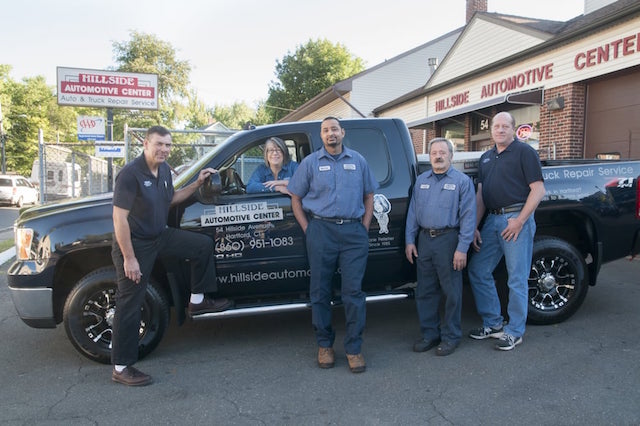Like every other aspect of our daily lives, keeping up proper maintenance on your car has likely been thrown into a tailspin over the past 12 months. Most of us have not been driving nearly as much as we typically do, whether that’s because we’re working from home, getting more things delivered, not traveling as much or, most likely, a combination of everything.
It’s easy to think that a car not being used as much won’t have any maintenance issues. But believe it or not, a vehicle doesn’t need to leave your driveway to suffer wear and tear. Add to this the fact that we’re coming out of winter, a season notorious for being tough on cars, and into spring, when potholes and other dangerous driving conditions arise.
This is all to say you should get your car inspected, repaired and maintained before you resume your regular driving routine.
We spoke with Gary Pelletier, owner of Approved Automotive Repair facility Hillside Automotive Center to get a better understanding of what automotive issues to look for as well as the best car maintenance practices.
With spring approaching, are there any particular car maintenance tasks people should complete as winter comes to a close?
Potholes are usually formed by ice during the winter and begin to pop up all over the place once the the ice melts in the spring. To prevent any damage that can come from driving over potholes, a good front end and suspension inspection, along with annual alignment, should be done.
Many people have been working from home and driving much less than usual. What maintenance issues can arise from a car not getting its normal use?
When cars sit too long, rust can build up on brake rotors. This causes brake issues when first using your car after it’s been sitting. Batteries can also discharge and not be able to be recharged. Another problem that people rarely think about are mice and other rodents finding homes in areas housing the car’s wires where they can cause major damage.
What is the biggest car maintenance myth/misconception?
The biggest car maintenance misconception is that an oil change alone is proper vehicle maintenance. Changing your car’s oil is just one part of proper vehicle maintenance. You need to get your entire vehicle inspected.
What’s the most common mistake people make in regard to keeping their car in good shape?
The most common mistake is not following up on necessary maintenance and repairs recommended by service providers.
Any other best tips/practices for keeping your vehicle in good shape?
If you can keep your car garaged, do it. Also, make sure to wash your vehicle as we head into spring, either at home or at a professional shop. Car washes that offer undercarriage washes are beneficial for getting road salt off the bottom of vehicles.
For the best car care, find a AAA Approved Auto Repair facility near you.
AAA members can save on automotive replacement parts and accessories at NAPA.
What automotive questions do you have for our mechanics? Let us know in the comments below.
9 Thoughts on “Ask a Mechanic: Is My Car Ready To Get Back on the Road?”
Leave A Comment
Comments are subject to moderation and may or may not be published at the editor’s discretion. Only comments that are relevant to the article and add value to the Your AAA community will be considered. Comments may be edited for clarity and length.

















Also when turning your engine off keep the steering wheel straight as the car won’t start until you turn the wheel very slightly to the left and then start the car
What are all the causes to bring up the engine warning light?
Too many to list. Auto supply stores will often lend a scanner to detect codes that cause the warning light to come on. Owning one of your own is not prohibitively expensive and allows monitoring systems even if an engine light has not been triggered. Unless you plan on doing repairs yourself, invest some time in finding a trustworthy shop.
Check your brake fluid. My brake light was going on only when I made a left turn . Adding brake fluid stopped this problem. Who knew?
Hi Fred, thanks for your question!. Here’s an answer from our Car Doctor, John Paul: There are actually two engine lights, a red engine warning light and a yellow check engine light. Typically the red engine light will come on when the engine is low on oil or the engine has very low oil pressure. If this light comes on, stop ASAP. Driving without oil or oil pressure will cause major damage to the engine.
The yellow check engine light can come on for dozens of reasons. This can be a simple as a loose gas cap to as complicated as a faulty computer communication. There are a dozen sensors that could be outside of their limits, which will turn the light on. In addition, sometimes the check engine light will flash. This indicates an engine misfire that could be due to a faulty spark plug, ignition coil or fuel injector. When the check engine light is on, the car’s computer will generate a computer code (there are dozens of codes). If you have a code feel free to reach out and I will see it we can come up with an answer.
What grade of tire should I buy, should I buy? 4 or only the 2 drive (front) tires?
Tires are best replaced in 4s. As for grade, at least matching any other tires on the car and the best you can afford. If only replacing two tires, the latest car thinking is that best tires go in the rear. That applies to two, four and front wheel drive.
Hi Arthur, thanks for reaching out!! Here’s an answer from John Paul, our Car Doctor: Regarding tires, most people in the Northeast buy all season tires. These tires are a bit of a compromise since they need to work in winter and summer — but for most drivers they do ok. If you live in very snowy areas or need to be out before the snow plows, there is nothing like four dedicated winter tires. Regarding how many tires to buy, it is always best to buy four, especially if the vehicle is all wheel drive. If you are only buying two tires the current wisdom is the new tires should be installed on the rear of the vehicle to prevent skidding. Let me know more about your vehicle and your driving and I can try to help you with a more specific recommendation.
Regarding tire choices (summer, all-season, winter, all-weather) with the tech changes in tire compounds and tread design, I have moved to all-weather. This avoids the danger of running all-season in the winter and the purchase, storage and swapping of dedicated winter tires on rims. On my two VW Hybrids I have seen no downgrade in choosing all-weather (ride good, mileage very good, traction very good).